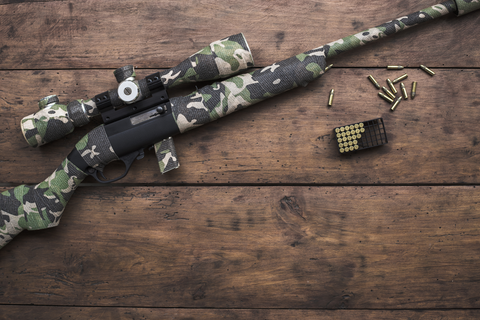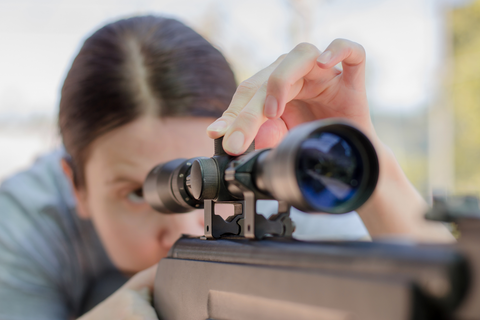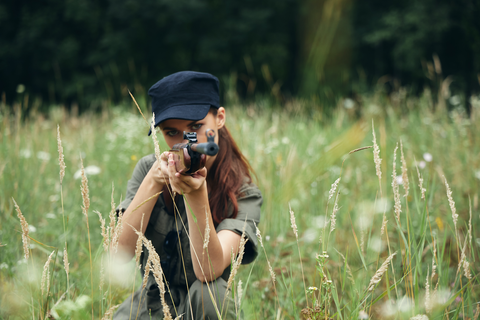Since the invention of guns, people have been fascinated by shooting accurately over longer distances. This fascination has turned into a hobby for many gun enthusiasts and even led to the introduction of competitions.
But what exactly is considered long-range? Short range usually means anything below 300 yards, while long range is anything beyond 300 yards but less than 1200 yards. Anything over a mile is considered extra long range. Because shooting over such distances requires more than just a steady hand and focus, there are many factors to consider if you want to enroll in a competition.
In this blog, we'll show you how long-range shooters can prepare for a long-range shooting competition.
What Type of Gun Should You Use?
Credit: Envato Elements/ ollinka
Typically, you should opt for a bolt-action rifle or a hunting rifle. Popular calibers include .308 Winchester, 6.5 Creedmoor, the Ruger Precision Rifle, and .300 Winchester Magnum.
When selecting long-range rifles, consider their barrel length and twist rate. A longer barrel generally offers better velocity, which is important for maintaining bullet stability over long distances. The twist rate of the barrel should match the weight of the bullets you plan to use; typically, heavier bullets require a faster twist to stabilize properly.
How to Prepare for a Long-Range Shooting Competition
Here are some handy tips to prepare for a long-distance competition shooting:
1) Learn How to Focus Under Pressure
Credit: Envato Elements/ kostinat
If you're stressed out when shooting, it significantly affects how steady your hand is and also how well you concentrate. Try practicing like you're in a real competition. Set time limits for your shots and score yourself as in a real event. Also, consider practicing where there is a lot of background noise like crowded ranges so that you get used to high-pressure situations.
Lastly, add breathing exercises to your training. Deep, steady breaths can calm your mind and body. Try breathing in deeply for a few counts, holding, and then exhaling slowly before each shot.
2) Try Dry Firing Practice
Credit: Envato Elements/ Vailery
Dry firing involves pulling the trigger of your firearm without live ammunition. This practice is safe, cost-effective, and an excellent way to hone your shooting skills and learn trigger control without the expense of live rounds. Consider using shooting bags when practicing to steady your aim. This technique is especially useful when using young guns.
To start with dry firing, check and double-check that there is no ammunition in the chamber. Once you have confirmed the firearm is safe, set up a target in a secure environment. Aim at the target as if you were using live rounds. Focus on maintaining your form, steadying your aim, and smoothly pulling the trigger.
3) Choose a Good Scope
Credit: Envato Elements/ oleksandrsh
A quality scope improves your accuracy by providing clear visibility and precise targeting capabilities at extended distances. When selecting a scope, first consider its magnification range. For long-range shooting, go for one with at least 10x magnification.
Next, examine the scope's reticle type. A reticle with hash marks or dots along the horizontal and vertical lines can be very helpful for estimating windage and elevation adjustments without manually adjusting the scope settings.
4) Consider Windage
Credit: Envato Elements/ shotprime
Wind can greatly affect the trajectory of a bullet over long distances. So, it's crucial to know how to deal with it for accurate shooting.
First off, start by learning how to read the wind. Use environmental indicators such as the movement of grass, trees, and even mirage patterns caused by heat on the ground. Next, understand how wind affects bullet flight. Generally, wind pushing from the side can push the bullet off course, requiring you to adjust your aim horizontally. The stronger the wind, the greater the adjustment needed.
5) Take a Class
Credit: Envato Elements/ smlub
Taking a class on long-range shooting is a valuable step in preparing for a competition. These classes can provide professional guidance and proven techniques specific to long-range accuracy.
Look for a class taught by experienced instructors who have a background in long-range shooting competitions. A good course will cover key topics such as understanding ballistics, proper shooting techniques, how to choose equipment, and how to read environmental conditions like wind and elevation.
6) Understand the Rules
Credit: Envato Elements/ karrastock
Knowing the regulations ensures that you comply with all requirements and avoid any penalties that could affect your performance. First, grab a copy of the competition rules from the organizer or their website. Study these rules carefully. Note any restrictions on match ammo types. Also, make sure you understand how the scoring works. That means knowing how points are awarded, what constitutes a penalty, and how ties are broken.
How Much Do Long-Range Shooting Competitions Cost?
Credit: Envato Elements/ boomeart
The entry fee for a competition for these shooting disciplines can vary significantly depending on the match location, and duration. Generally, entry fees range from $100 to $300. For high-level competitions or those held over several days, fees can be higher, sometimes exceeding $500.
Summary
Long-range shooting is a challenging and rewarding sport that requires precision, discipline, and a thorough understanding of various factors like equipment, environmental conditions, and personal skills. With dedication and proper preparation, you can significantly enhance your long-range shooting abilities and enjoy success in competitions.
Are you ready to step up your game? Check out EasyShot Shooting Targets! Our long-range targets are designed for maximum visibility and durability, making them perfect for honing your long-range target shooting skills. Our targets are suitable for both beginner and experienced shooters. Shop with us today.









